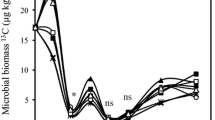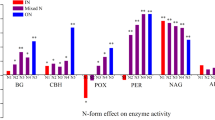Abstract
The effect of grassland conversion to cropland on the incorporation of N into microbial residues remains unclear. We analyzed for amino sugars, as a microbial residue biomarker, and adopted stable-isotope-probing technique to trace the assimilation of 15NH4+-N (added in the form of 15 N-labelled ammonium sulphate) into amino sugars with or without organic C sources (glucose and crop residue) in native grassland and converted cropland soils over a 65-day period. Total 15 N-amino sugars in the cropland were significantly decreased by 16–29% compared to grassland regardless of C source. This suggests that the microbial assimilation of available N into microbial residues was decreased, after conversion, and that stronger responses to substrate inputs occurred in the grassland soils. The addition of available and complex C substrates triggered divergent accumulation patterns of 15 N-amino sugars, indicating that C availability was a major driver for microbial N immobilization. Meanwhile, the conversion of grassland led to suppressed N immobilization activity of both fungi and bacteria. These results suggest that long-term land-use change could considerably affect the N utilization by fungi and bacteria during their anabolic processes, which may exert long-lasting impacts on soil organic N storage.





Similar content being viewed by others
References
Amelung W (2001) Methods using amino sugars as markers for microbial residues in soil. In: Lal JM, Follett RF, Stewart BA (eds) Assessment methods for soil carbon. Lewis Publishers, Boca Raton, pp 233–272
Amelung W, Brodowski S, Sandhage-Hofmann A, Bol R (2008) Combining biomarker with stable isotope analyses for assessing the transformation and turnover of soil organic matter. In: Donald LS (ed) Advances in Agronomy. Academic Press, London, pp 155–250
Appuhn A, Joergensen RG (2006) Microbial colonisation of roots as a function of plant species. Soil Biol Biochem 38:1040–1051
Aye NS, Butterly CR, Sale PWG, Tang C (2018) Interactive effects of initial pH and nitrogen status on soil organic carbon priming by glucose and lignocellulose. Soil Biol Biochem 123:33–44
Blagodatskaya EV, Blagodatsky SA, Anderson TH, Kuzyakov Y (2007) Priming effects in Chernozem induced by glucose and N in relation to microbial growth strategies. Appl Soil Ecol 37:95–105
Brant JB, Sulzman EW, Myrold DD (2006) Microbial community utilization of added carbon substrates in response to long-term carbon input manipulation. Soil Biol Biochem 38:2219–2232
Cotrufo MF, Wallenstein MD, Boot CM, Denef K, Paul E (2013) The microbial efficiency-matrix stabilization MEMS framework integrates plant litter decomposition with soil organic matter stabilization: do labile plant inputs form stable organic matter? Glob Chang Biol 19:988–995
Ding XL, Han XZ, Zhang XD, Qiao YF (2013) Effects of contrasting agricultural management on microbial residues in a Mollisol in China. Soil till Res 130:13–17
Ding XL, Zhang B, Wei ZB, He HB, Filley TR (2020) Conversion of grassland into cropland affects microbial residue carbon retention in both surface and subsurface soils of a temperate agroecosystem. Biol Fertil Soils 56:137–143
Dungait JA, Hopkins DW, Gregory AS, Whitmore AP (2012) Soil organic matter turnover is governed by accessibility not recalcitrance. Glob Chang Biol 18:1781–1796
Engelking B, Flessa H, Joergensen RG (2007) Shifts in amino sugar and ergosterol contents after addition of sucrose and cellulose to soil. Soil Biol Biochem 39:2111–2118
Fierer N (2017) Embracing the unknown: disentangling the complexities of the soil microbiome. Nat Rev Microbiol 15:579
Geisseler D, Patricia ALazicki PA, Scow KM (2016) Mineral nitrogen input decreases microbial biomass in soils under grasslands but not annual crops. Appl Soil Ecol 106:1–10
Glaser B, Gross S (2005) Compound-specific δ13C analysis of individual amino sugars - a tool to quantify timing and amount of soil microbial residue stabilization. Rapid Commun Mass Spectrom 19:1409–1416
Glaser B, Millar N, Blum H (2006) Sequestration and turnover of bacterial- and fungal-derived carbon in a temperate grassland soil under long-term elevated atmospheric pCO2. Glob Chang Biol 12:1521–1531
Glaser B, Turrión MB, Alef K (2004) Amino sugars and muramic acid – biomarkers for soil microbial community structure analysis. Soil Biol Biochem 36:399–407
He H, Xie H, Zhang X (2006) A novel GC/MS technique to assess 15N and 13C incorporation into soil amino sugars. Soil Biol Biochem 38:1083–1091
He H, Zhang W, Zhang X, Xie H, Zhuang J (2011) Temporal responses of soil microorganisms to substrate addition as indicated by amino sugar differentiation. Soil Biol Biochem 43:1155–1161
Hodge A (2014) Interactions between arbuscular mycorrhizal fungi and organic material substrates. Adv Appl Microbiol 89:47–99
Högberg P, Read DJ (2006) Towards a more plant physiological perspective on soil ecology. Trends Ecol Evol 21:548–554
Hoyle FC, Murphy DV, Brookes PC (2008) Microbial response to the addition of glucose in low-fertility soils. Biol Fertil Soils 44:571–579
Huang Y, Liang C, Duan XW, Chen H, Li DJ (2019) Variation of microbial residue contribution to soil organic carbon sequestration following land use change in a subtropical karst region. Geoderma 353:340–346
IUSS Working Group WRB (2015) World Reference Base for Soil Resources 2014, update 2015. International soil classification system for naming soils and creating legends for soil maps. World Soil Resources Reports No. 106. FAO, Rome
Joergensen RG (2018) Amino sugars as specific indices for fungal and bacterial residues in soil. Biol Fertil Soils 54:559–568
Joergensen RG, Wichern F (2008) Quantitative assessment of the fungal contribution to microbial tissue in soil. Soil Biol Biochem 40:2977–2991
Kallenbach CM, Frey SD, Grandy AS (2016) Direct evidence for microbial-derived soil organic matter formation and its ecophysiological controls. Nat Commun 7:13630
Koranda M, Kaiser C, Fuchslueger L, Kitzler B, Sessitsch A, Zechmeister-Boltenstern S, Richter A (2014) Fungal and bacterial utilization of organic substrates depends on substrate complexity and N availability. FEMS Microbiol Ecol 87:142–152
Lauer F, Kösters R, du Preez CC, Amelung W (2011) Microbial residues as indicators of soil restoration in South African secondary pastures. Soil Biol Biochem 43:787–794
Lehmann J, Kleber M (2015) The contentious nature of soil organic matter. Nature 528:60
Li LD, Wilson CB, He HB, Zhang XD, Zhou F, Schaeffer SM (2019a) Physical, biochemical, and microbial controls on amino sugar accumulation in soils under long-term cover cropping and no-tillage farming. Soil Biol Biochem 135:369–378
Li XB, He HB, Zhang XD, Yan XY, Six J, Cai ZC, Barthel M, Zhang JB, Necpalova M, Ma QQ, Li ZA (2019b) Distinct responses of soil fungal and bacterial nitrate immobilization to land conversion from forest to agriculture. Soil Biol Biochem 134:81–89
Liang C, Balser TC (2010) Mass spectrometric characterization of amino sugar aldononitrile acetate derivatives used for isotope enrichment assessment of microbial residues. Soil Biol Biochem 42:904–909
Liang C, Schimel JD, Jastrow JD (2017) The importance of anabolism in microbial control over soil carbon storage. Nat Microbiol 2:17105
Liang C, Wulf Amelung W, Johannes Lehmann J, Kästner M (2019) Quantitative assessment of microbial necromass contribution to soil organic matter. Glob Change Biol 25:3578–3590
Miltner A, Bombach P, Schmidt-Brücken B, Kästner M (2012) SOM genesis: microbial biomass as a significant source. Biogeochemistry 111:41–55
Mondini C, Cayuela ML, Sanchez-Monedero MA, Roig A, Brookes PC (2006) Soil microbial biomass activation by trace amounts of readily available substrate. Biol Fertil Soils 42:542–549
Mooshammer M, Wanek W, Zechmeister-Boltenstern S, Richter A (2014) Stoichiometric imbalances between terrestrial decomposer communities and their resources: mechanisms and implications of microbial adaptations to their resources. Front Microbiol 5:1–10
Morita RY (1988) Bioavailability of energy and its relationship to growth and starvation survival in nature. Can J Microbiol 34:436–441
Perelo LW, Jimenez M, Munch JC (2006) Microbial immobilization and turnover of 15N labelled substrates in two arable soils under field and laboratory conditions. Soil Biol Biochem 38:912–922
Postma-Blaauw MB, de Goede RGM, Bloem J, Faber JH, Brussaard L (2010) Soil biota community structure and abundance under agricultural intensification and extensification. Ecology 91:460–473
Six J, Frey SD, Thiet RK, Batten KM (2006) Bacterial and fungal contributions to carbon sequestration in agroecosystems. Soil Sci Soc Am J 70:555–569
Sokol NW, Sanderman J, Bradford MA (2019) Pathways of mineral - associated soil organic matter formation: integrating the role of plant carbon source, chemistry, and point of entry. Glob Change Biol 25:12–24
Song M, Yu L, Fu S, Korpelainen H, Li C (2020) Stoichiometric flexibility and soil bacterial communities respond to nitrogen fertilization and neighbor competition at the early stage of primary succession. Biol Fertil Soils 56:1121–1135
Song XD, Yang F, Ju B, Li DC, Zhao YG, Yang JL, Zhang GL (2018) The influence of the conversion of grassland to cropland on changes in soil organic carbon and total nitrogen stocks in the Songnen Plain of Northeast China. CATENA 171:588–601
Strickland MS, Rousk J (2010) Considering fungal:bacterial dominance in soils –methods, controls, and ecosystem implications. Soil Biol Biochem 42:1385–1395
Wang C, Wang X, Pei GT, Xia ZW, Peng B, Sun LF, Wang J, Gao D, Chen SD, Liu DW, Dai WW, Jiang P, Fang YT, Liang C, Wu NP, Bai E (2020) Stabilization of microbial residues in soil organic matter after two years of decomposition. Soil Biol Biochem 141:107687
Wang XX, Zhang W, Zhou F, Liu Y, He HB, Zhang XD (2020) Distinct regulation of microbial processes in the immobilization of labile carbon in different soils. Soil Biol Biochem 142:107723
Wang X, Wang C, Cotrufo MF, Sun LF, Jiang P, Bai E (2020c) Elevated temperature increases the accumulation of microbial necromass nitrogen in soil via increasing microbial turnover. Glob Change Biol 26:5277–5289
Wei X, Zhu Z, Liu Y, Luo Y, Deng Y, Xu X, Liu S, Richter A, Shibistova O, Guggenberger G, Wu J, Ge T (2020) C:N: P stoichiometry regulates soil organic carbon mineralization and concomitant shifts in microbial community composition in paddy soil. Biol Fertil Soils 56:1093–1107
Xu SQ, Zhang B, Ma LN, Hou AX (2017) Effects of marsh cultivation and restoration on soil microbial communities in the Sanjiang Plain, northeastern China. Eur J Soil Biol 82:81–87
Ye Y, Fang XQ (2011) Spatial pattern of land cover changes across Northeast China over the past 300 years. J Hist Geogr 37:408–417
Yuan X, Qin WK, Xu H, Zhang ZH, Zhou HK, Zhu B (2020) Sensitivity of soil carbon dynamics to nitrogen and phosphorus enrichment in an alpine meadow. Soil Biol Biochem 150:107984
Zak DR, Pregitzer KS, Burton AJ, Edwards IP, Kellner H (2011) Microbial responses to a changing environment: implications for the future functioning of terrestrial ecosystems. Fungal Ecol 4:386–395
Zhang W, Zhang XC, Bai E, CuiYH HHB, Zhang XD (2020) The strategy of microbial utilization of the deposited N in a temperate forest soil. Biol Fertil Soils 56:359–367
Zhang X, Amelung W (1996) Gas chromatographic determination of muramic acid, glucosamine, mannosamine, and galactosamine in soils. Soil Biol Biochem 28:1201–1206
Zheng Q, Hu Y, Zhang S, Noll L, Böckle T, Richter A, Wanek W (2019) Growth explains microbial carbon use efficiency across soils differing in land use and geology. Soil Biol Biochem 128:45–55
Zogg GP, Zak DR, Pregitzer KS, Burton AJ (2000) Microbial immobilization and the retention of anthropogenic nitrate in a northern hardwood forest. Ecology 81:1858–1866
Funding
This work was financially supported by the National Natural Science Foundation of China (42077085; 41630862) and the Startup Foundation for Introducing Talent of NUIST (2018r100).
Author information
Authors and Affiliations
Corresponding authors
Additional information
Publisher's note
Springer Nature remains neutral with regard to jurisdictional claims in published maps and institutional affiliations.
Rights and permissions
About this article
Cite this article
Ding, X., Zhang, B., Chen, Q. et al. Grassland conversion to cropland decreased microbial assimilation of mineral N into their residues in a Chernozem soil. Biol Fertil Soils 57, 913–924 (2021). https://doi.org/10.1007/s00374-021-01581-1
Received:
Revised:
Accepted:
Published:
Issue Date:
DOI: https://doi.org/10.1007/s00374-021-01581-1




